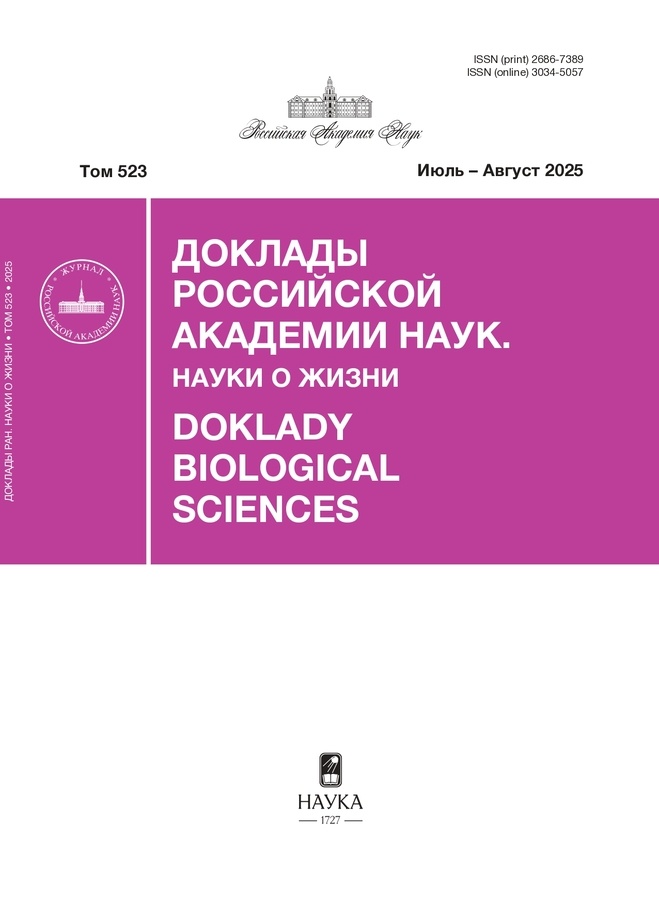Error-prone DNA synthesis on click-ligated templates
- Authors: Endutkin A.V.1, Yakovlev A.O.1,2, Zharkov T.D.1, Golyshev V.M.1, Yudkina A.V.1, Zharkov D.O.1,2
-
Affiliations:
- Institute of Chemical Biology and Fundamental Medicine SB RAS
- Novosibirsk State University
- Issue: Vol 518, No 1 (2024)
- Pages: 101-107
- Section: Articles
- URL: https://kld-journal.fedlab.ru/2686-7389/article/view/651407
- DOI: https://doi.org/10.31857/S2686738924050186
- ID: 651407
Cite item
Abstract
Click ligation is a technology of joining DNA fragments based on azide–alkyne cycloaddition. In the most common variant, click ligation introduces a 4-methyl-1,2,3-triazole (trz) group instead of the phosphodiester bond between two adjacent nucleosides. While this linkage is believed to be biocompatible, little is known about the possibility of its recognition by DNA repair systems or its potential for DNA polymerase stalling and miscoding. Here we report that trz linkage is resistant to several human and bacterial endonucleases involved in DNA repair. At the same time, it strongly blocks some DNA polymerases (Pfu, DNA polymerase β) while allowing bypass by others (phage RB69 polymerase, Klenow fragment). All polymerases except for DNA polymerase β showed high frequency of misinsertion at the trz site, incorporating dAMP instead of the next complementary nucleotide. Thus, click ligation may be expected to produce a large amount of errors if used in custom gene synthesis.
Keywords
Full Text
About the authors
A. V. Endutkin
Institute of Chemical Biology and Fundamental Medicine SB RAS
Email: dzharkov@niboch.nsc.ru
Russian Federation, Novosibirsk
A. O. Yakovlev
Institute of Chemical Biology and Fundamental Medicine SB RAS; Novosibirsk State University
Email: dzharkov@niboch.nsc.ru
Russian Federation, Novosibirsk; Novosibirsk
T. D. Zharkov
Institute of Chemical Biology and Fundamental Medicine SB RAS
Email: dzharkov@niboch.nsc.ru
Russian Federation, Novosibirsk
V. M. Golyshev
Institute of Chemical Biology and Fundamental Medicine SB RAS
Email: dzharkov@niboch.nsc.ru
Russian Federation, Novosibirsk
A. V. Yudkina
Institute of Chemical Biology and Fundamental Medicine SB RAS
Email: dzharkov@niboch.nsc.ru
Russian Federation, Novosibirsk
D. O. Zharkov
Institute of Chemical Biology and Fundamental Medicine SB RAS; Novosibirsk State University
Author for correspondence.
Email: dzharkov@niboch.nsc.ru
Corresponding Member of the RAS
Russian Federation, Novosibirsk; NovosibirskReferences
- Rostovtsev V.V., Green L.G., Fokin V.V., et al. A stepwise Huisgen cycloaddition process: Copper(I)-catalyzed regioselective ligation of azides and terminal alkynes, Angew. Chem. Int. Ed., 2002, vol. 41, no. 14, pp. 2596–2599.
- Tornøe C.W., Christensen C., and Meldal M. Peptidotriazoles on solid phase: [1,2,3]-Triazoles by regiospecific copper(I)-catalyzed 1,3-dipolar cycloadditions of terminal alkynes to azides, J. Org. Chem. 2002, vol. 67, no. 9. pp. 3057–3064.
- Gierlich J., Burley G.A., Gramlich P.M.E., et al. Click chemistry as a reliable method for the high-density postsynthetic functionalization of alkyne-modified DNA, Org. Lett., 2006, vol. 8, no. 17, pp. 3639–3642.
- Seela F., and Sirivolu V.R. DNA containing side chains with terminal triple bonds: Base-pair stability and functionalization of alkynylated pyrimidines and 7-deazapurines, Chem. Biodivers., 2006, vol. 3, no. 5. pp. 509–514.
- El-Sagheer A.H., Sanzone A.P., Gao R., et al. Biocompatible artificial DNA linker that is read through by DNA polymerases and is functional in Escherichia coli, Proc. Natl Acad. Sci. U.S.A., 2011, vol. 108, no. 28, pp. 11338–11343.
- Sanzone A.P., El-Sagheer A.H., Brown T., and Tavassoli A. Assessing the biocompatibility of click-linked DNA in Escherichia coli, Nucleic Acids Res., 2012, vol. 40, no. 20, pp. 10567–10575.
- Dallmann A., El-Sagheer A.H., Dehmel L., et al. Structure and dynamics of triazole-linked DNA: Biocompatibility explained, Chemistry, 2011, vol. 17, no. 52, pp. 14714–14717.
- El-Sagheer A.H., and Brown T. New strategy for the synthesis of chemically modified RNA constructs exemplified by hairpin and hammerhead ribozymes, Proc. Natl Acad. Sci. U.S.A., 2010, vol. 107, no. 35, pp. 15329–15334.
- El-Sagheer A.H., and Brown T. Efficient RNA synthesis by in vitro transcription of a triazole-modified DNA template, Chem. Commun., 2011, vol. 47, no. 44, pp. 12057–12058.
- Rothwell P.J., and Waksman G. Structure and mechanism of DNA polymerases, Adv. Protein Chem., 2005, vol. 71, pp. 401–440.
- Endutkin A.V., Yudkina A.V., Zharkov T.D., et al. Recognition of a clickable abasic site analog by DNA polymerases and DNA repair enzymes, Int. J. Mol. Sci., 2022, vol. 23, no. 21, 13353.
- Ishchenko A.A., Ide H., Ramotar D., et al. α-Anomeric deoxynucleotides, anoxic products of ionizing radiation, are substrates for the endonuclease IV-type AP endonucleases, Biochemistry, 2004, vol. 43, no. 48, pp. 15210–15216.
- Du X., Yang Z., Xie G., et al. Molecular basis of the plant ROS1-mediated active DNA demethylation, Nat. Plants, 2023, vol. 9, no. 2, pp. 271–279.
- Shen J.-C., Creighton S., Jones P.A., and Goodman M.F. A comparison of the fidelity of copying 5-methylcytosine and cytosine at a defined DNA template site, Nucleic Acids Res., 1992, vol. 20, no. 19, pp. 5119–5125.
- Zahn K.E., Averill A., Wallace S.S., and Doublié S. The miscoding potential of 5-hydroxycytosine arises due to template instability in the replicative polymerase active site, Biochemistry, 2011, vol. 50, no. 47, pp. 10350–10358.
- Howard M.J., Foley K.G., Shock D.D., et al. Molecular basis for the faithful replication of 5-methylcytosine and its oxidized forms by DNA polymerase β, J. Biol. Chem., 2019, vol. 294, no. 18, pp. 7194–7201.
- Taylor J.-S. New structural and mechanistic insight into the A-rule and the instructional and non-instructional behavior of DNA photoproducts and other lesions, Mutat. Res., 2002, vol. 510, no. 1–2, pp. 55–70.
- Obeid S., Baccaro A., Welte W., et al. Structural basis for the synthesis of nucleobase modified DNA by Thermus aquaticus DNA polymerase, Proc. Natl Acad. Sci. U.S.A., 2010, vol. 107, no. 50, pp. 21327–21331.
- Xia S., Vashishtha A., Bulkley D. et al. Contribution of partial charge interactions and base stacking to the efficiency of primer extension at and beyond abasic sites in DNA, Biochemistry, 2012, vol. 51, no. 24, pp. 4922–4931.
- Beard W.A., Shock D.D., Batra V.K. et al. DNA polymerase β substrate specificity: Side chain modulation of the “A-rule”, J. Biol. Chem., 2009, vol. 284, no. 46, pp. 31680–31689.
Supplementary files














